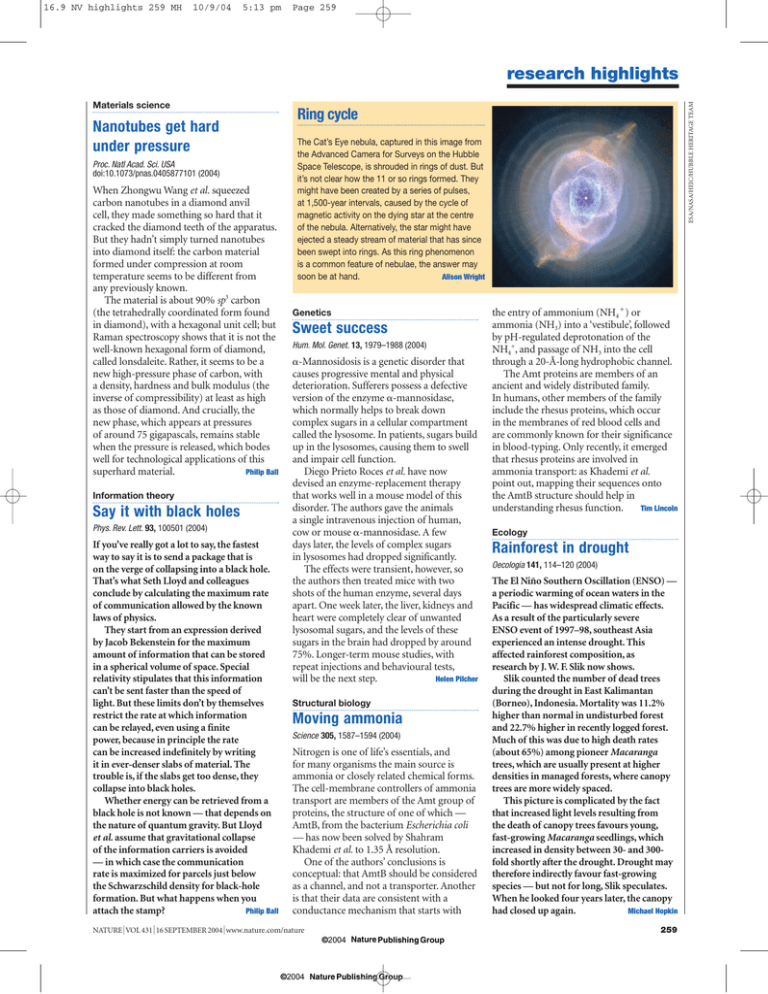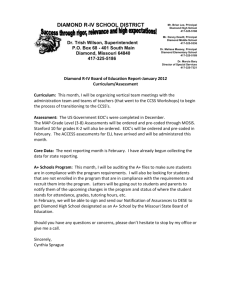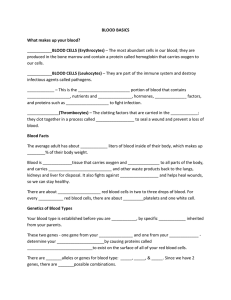Nanotubes get hard under pressure
advertisement

16.9 NV highlights 259 MH 10/9/04 5:13 pm Page 259 Materials science Nanotubes get hard under pressure Proc. Natl Acad. Sci. USA doi:10.1073/pnas.0405877101 (2004) When Zhongwu Wang et al. squeezed carbon nanotubes in a diamond anvil cell, they made something so hard that it cracked the diamond teeth of the apparatus. But they hadn’t simply turned nanotubes into diamond itself: the carbon material formed under compression at room temperature seems to be different from any previously known. The material is about 90% sp3 carbon (the tetrahedrally coordinated form found in diamond), with a hexagonal unit cell; but Raman spectroscopy shows that it is not the well-known hexagonal form of diamond, called lonsdaleite. Rather, it seems to be a new high-pressure phase of carbon, with a density, hardness and bulk modulus (the inverse of compressibility) at least as high as those of diamond. And crucially, the new phase, which appears at pressures of around 75 gigapascals, remains stable when the pressure is released, which bodes well for technological applications of this superhard material. Philip Ball Information theory Say it with black holes Phys. Rev. Lett. 93, 100501 (2004) If you’ve really got a lot to say, the fastest way to say it is to send a package that is on the verge of collapsing into a black hole. That’s what Seth Lloyd and colleagues conclude by calculating the maximum rate of communication allowed by the known laws of physics. They start from an expression derived by Jacob Bekenstein for the maximum amount of information that can be stored in a spherical volume of space. Special relativity stipulates that this information can’t be sent faster than the speed of light. But these limits don’t by themselves restrict the rate at which information can be relayed, even using a finite power, because in principle the rate can be increased indefinitely by writing it in ever-denser slabs of material. The trouble is, if the slabs get too dense, they collapse into black holes. Whether energy can be retrieved from a black hole is not known — that depends on the nature of quantum gravity. But Lloyd et al. assume that gravitational collapse of the information carriers is avoided — in which case the communication rate is maximized for parcels just below the Schwarzschild density for black-hole formation. But what happens when you Philip Ball attach the stamp? ESA/NASA/HEIC/HUBBLE HERITAGE TEAM research highlights Ring cycle The Cat’s Eye nebula, captured in this image from the Advanced Camera for Surveys on the Hubble Space Telescope, is shrouded in rings of dust. But it’s not clear how the 11 or so rings formed. They might have been created by a series of pulses, at 1,500-year intervals, caused by the cycle of magnetic activity on the dying star at the centre of the nebula. Alternatively, the star might have ejected a steady stream of material that has since been swept into rings. As this ring phenomenon is a common feature of nebulae, the answer may soon be at hand. Alison Wright Genetics Sweet success Hum. Mol. Genet. 13, 1979–1988 (2004) -Mannosidosis is a genetic disorder that causes progressive mental and physical deterioration. Sufferers possess a defective version of the enzyme -mannosidase, which normally helps to break down complex sugars in a cellular compartment called the lysosome. In patients, sugars build up in the lysosomes, causing them to swell and impair cell function. Diego Prieto Roces et al. have now devised an enzyme-replacement therapy that works well in a mouse model of this disorder. The authors gave the animals a single intravenous injection of human, cow or mouse -mannosidase. A few days later, the levels of complex sugars in lysosomes had dropped significantly. The effects were transient, however, so the authors then treated mice with two shots of the human enzyme, several days apart. One week later, the liver, kidneys and heart were completely clear of unwanted lysosomal sugars, and the levels of these sugars in the brain had dropped by around 75%. Longer-term mouse studies, with repeat injections and behavioural tests, will be the next step. Helen Pilcher Structural biology Moving ammonia Science 305, 1587–1594 (2004) Nitrogen is one of life’s essentials, and for many organisms the main source is ammonia or closely related chemical forms. The cell-membrane controllers of ammonia transport are members of the Amt group of proteins, the structure of one of which — AmtB, from the bacterium Escherichia coli — has now been solved by Shahram Khademi et al. to 1.35 Å resolution. One of the authors’ conclusions is conceptual: that AmtB should be considered as a channel, and not a transporter. Another is that their data are consistent with a conductance mechanism that starts with NATURE | VOL 431 | 16 SEPTEMBER 2004 | www.nature.com/nature the entry of ammonium (NH4) or ammonia (NH3) into a ‘vestibule’, followed by pH-regulated deprotonation of the NH4+, and passage of NH3 into the cell through a 20-Å-long hydrophobic channel. The Amt proteins are members of an ancient and widely distributed family. In humans, other members of the family include the rhesus proteins, which occur in the membranes of red blood cells and are commonly known for their significance in blood-typing. Only recently, it emerged that rhesus proteins are involved in ammonia transport: as Khademi et al. point out, mapping their sequences onto the AmtB structure should help in understanding rhesus function. Tim Lincoln Ecology Rainforest in drought Oecologia 141, 114–120 (2004) The El Niño Southern Oscillation (ENSO) — a periodic warming of ocean waters in the Pacific — has widespread climatic effects. As a result of the particularly severe ENSO event of 1997–98, southeast Asia experienced an intense drought. This affected rainforest composition, as research by J. W. F. Slik now shows. Slik counted the number of dead trees during the drought in East Kalimantan (Borneo), Indonesia. Mortality was 11.2% higher than normal in undisturbed forest and 22.7% higher in recently logged forest. Much of this was due to high death rates (about 65%) among pioneer Macaranga trees, which are usually present at higher densities in managed forests, where canopy trees are more widely spaced. This picture is complicated by the fact that increased light levels resulting from the death of canopy trees favours young, fast-growing Macaranga seedlings, which increased in density between 30- and 300fold shortly after the drought. Drought may therefore indirectly favour fast-growing species — but not for long, Slik speculates. When he looked four years later, the canopy Michael Hopkin had closed up again. 259 ©2004 Nature Publishing Group ©2004 Nature Publishing Group




